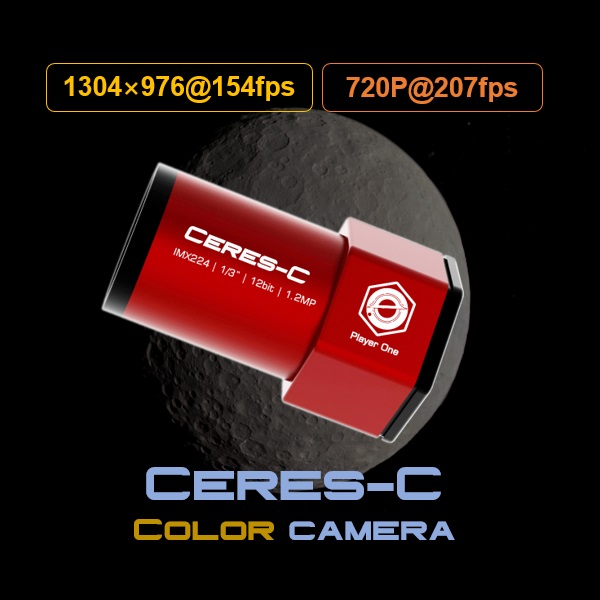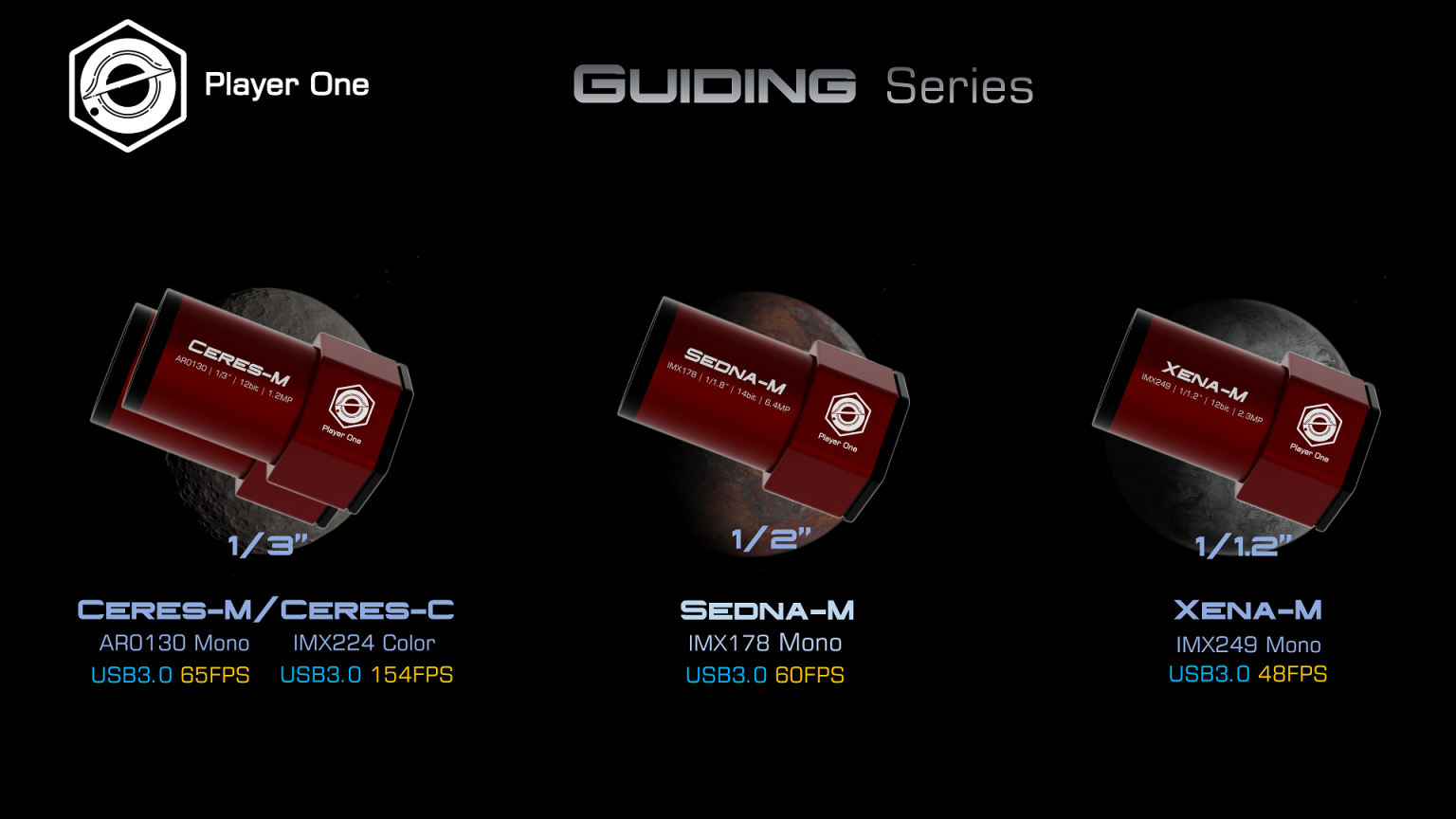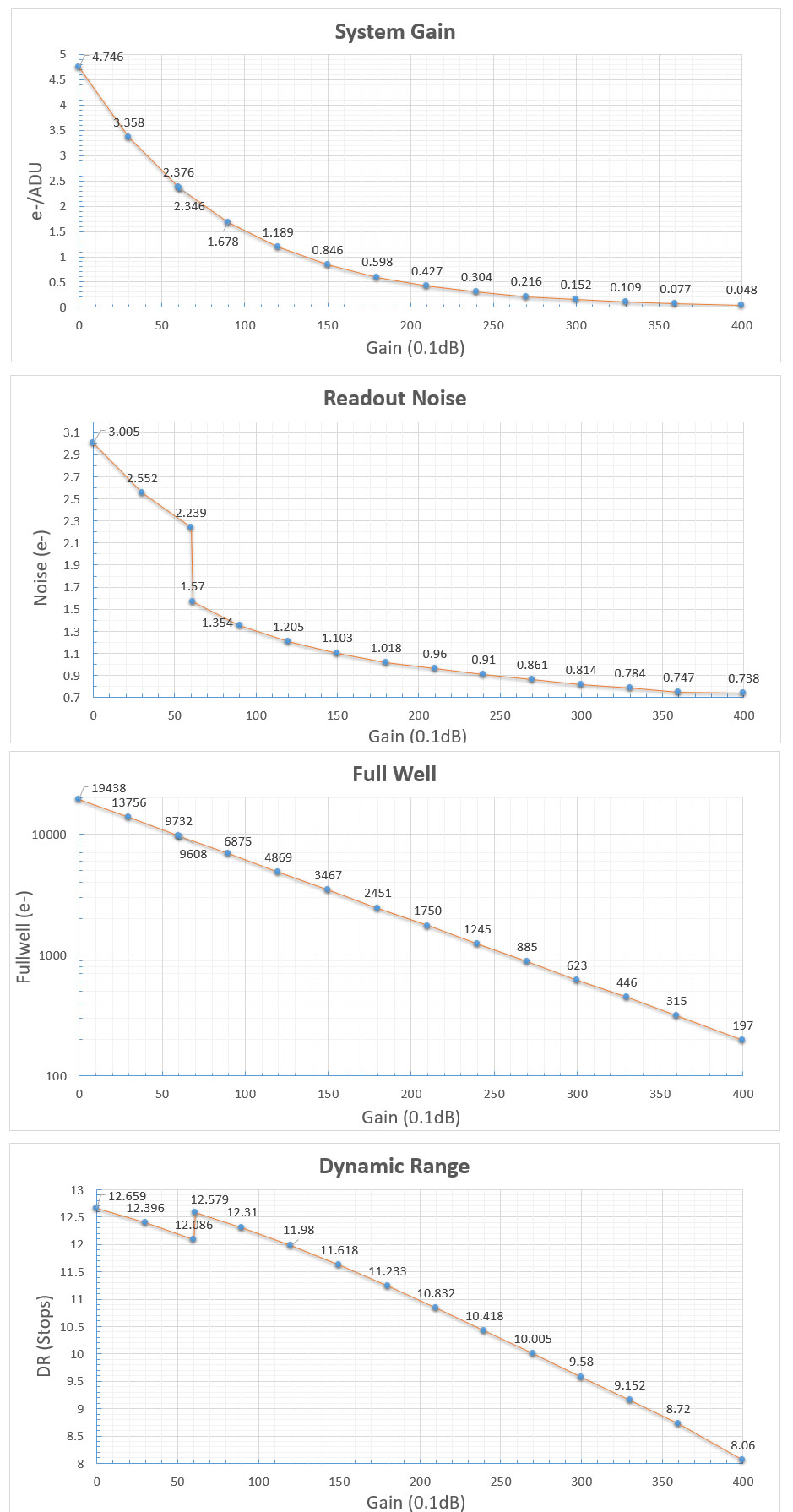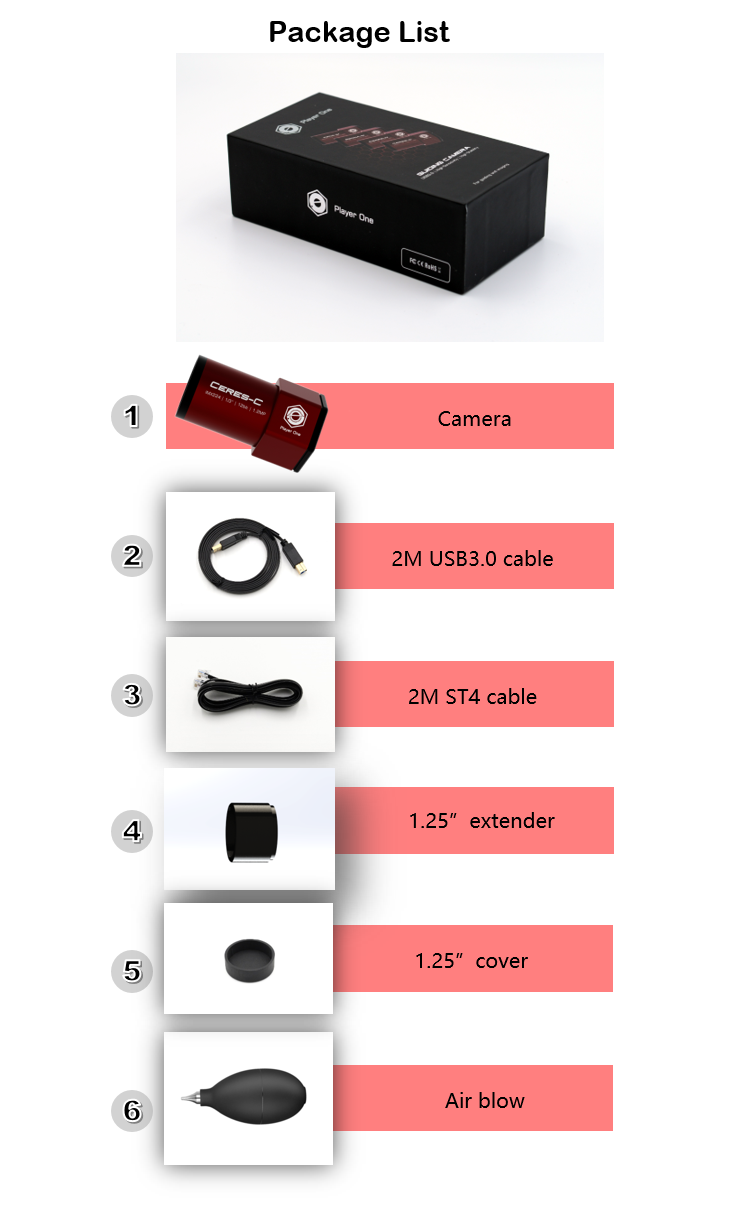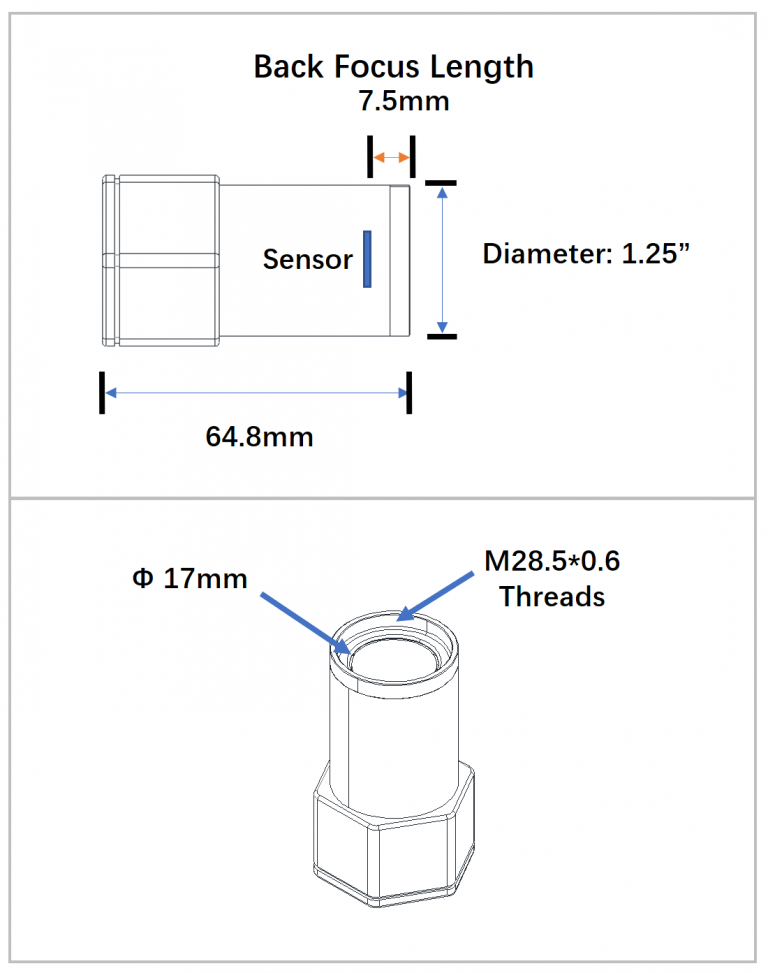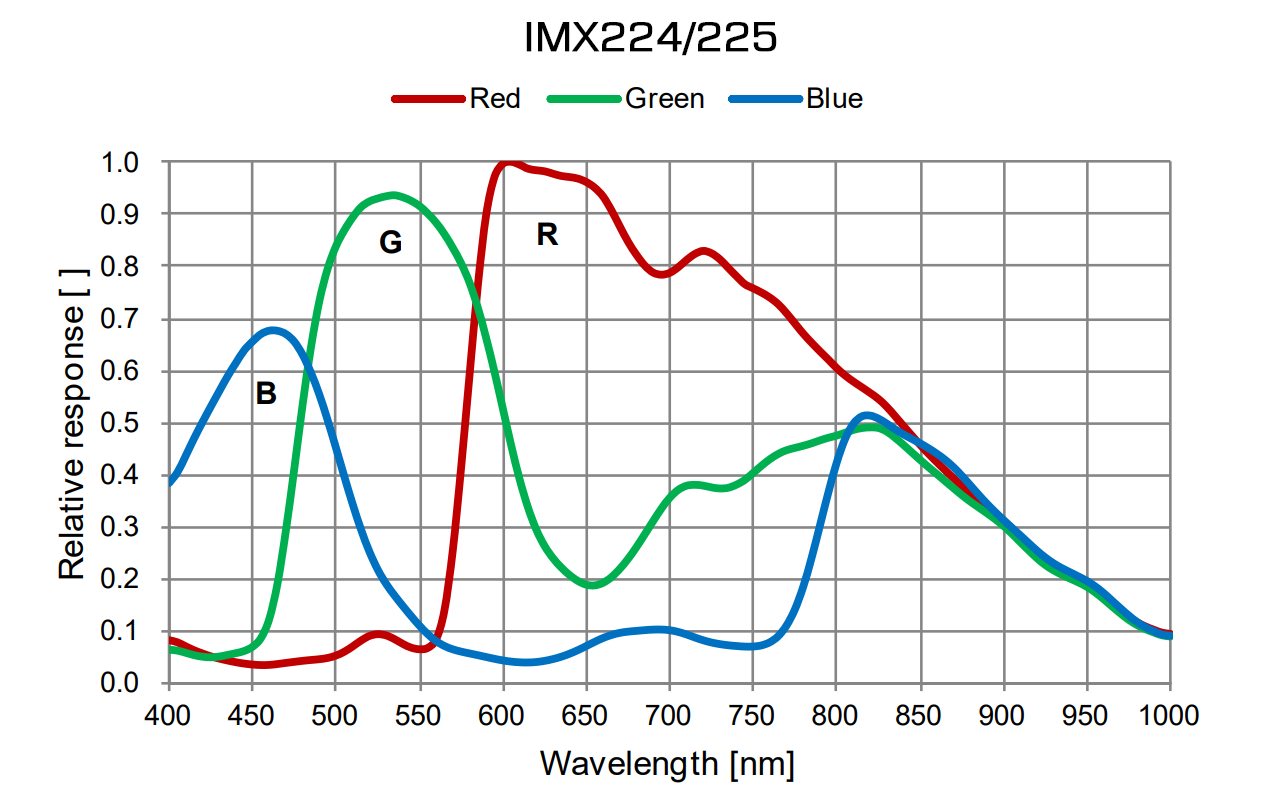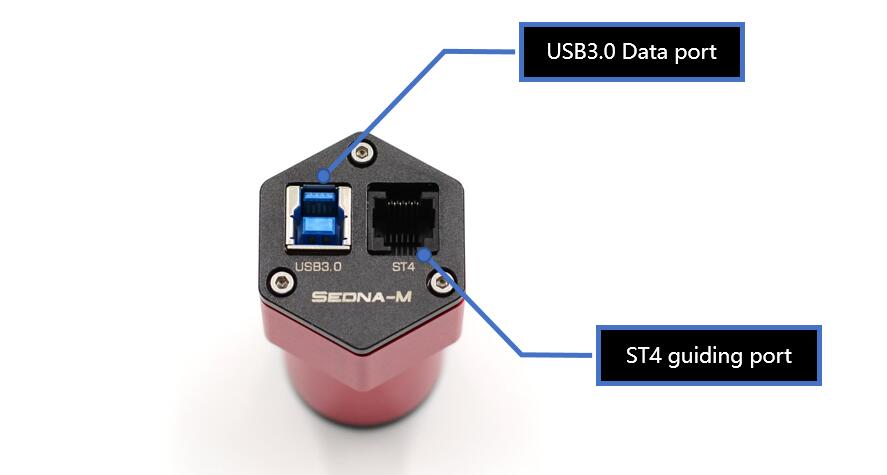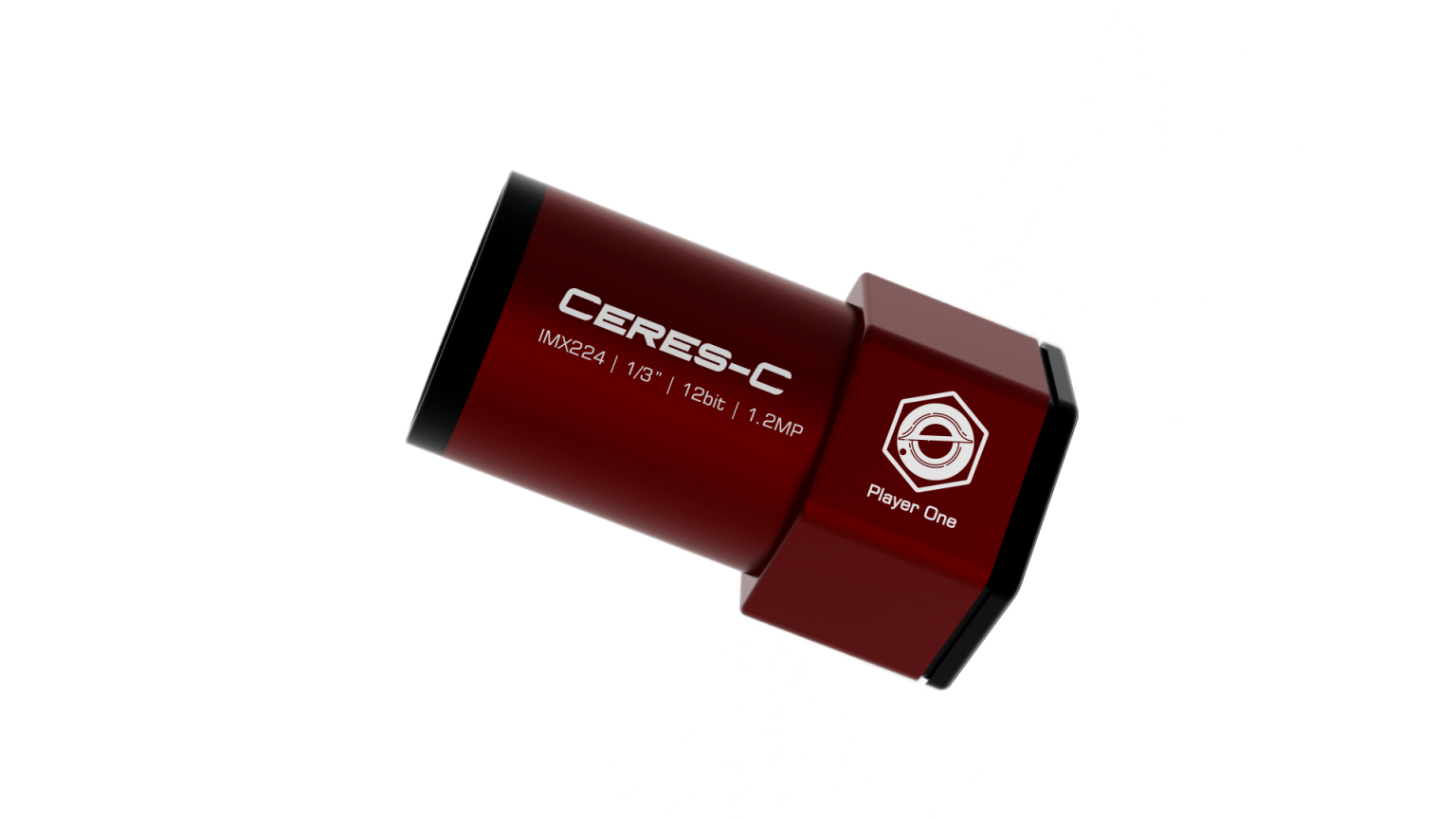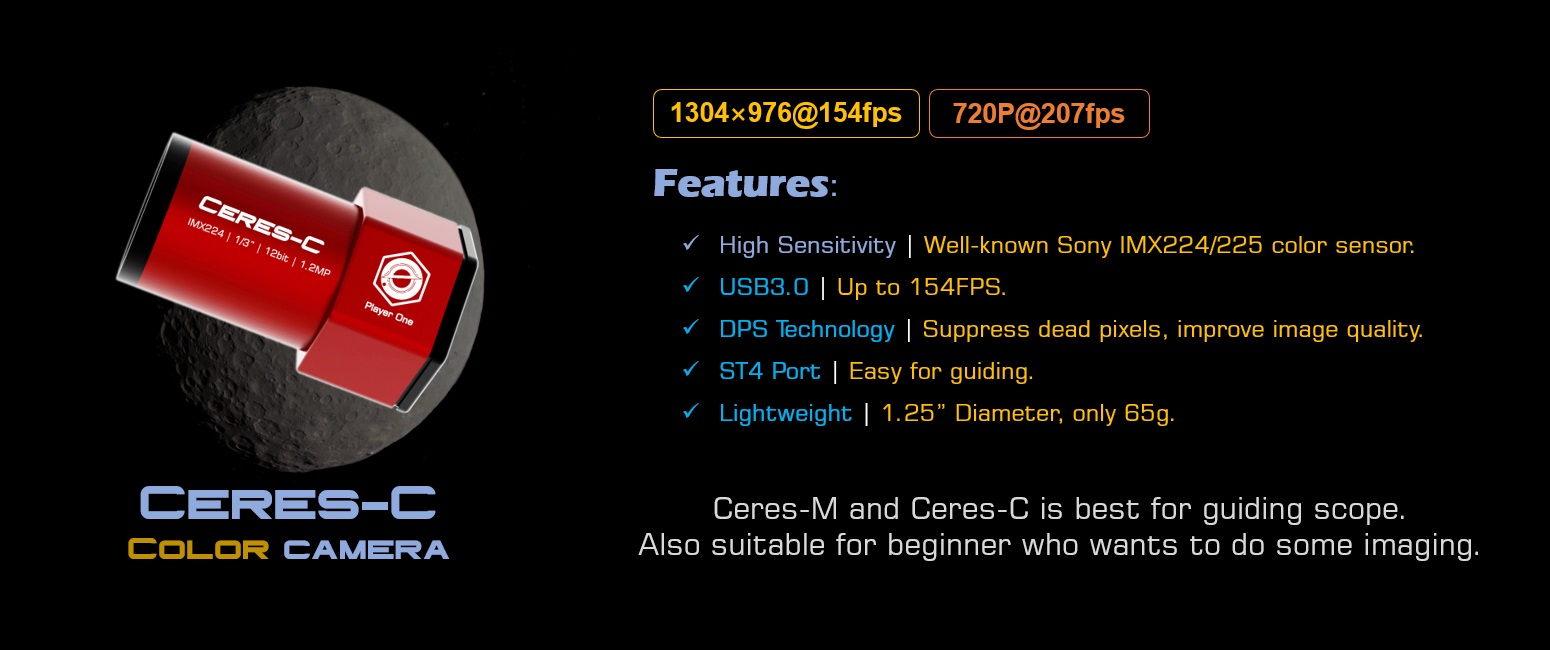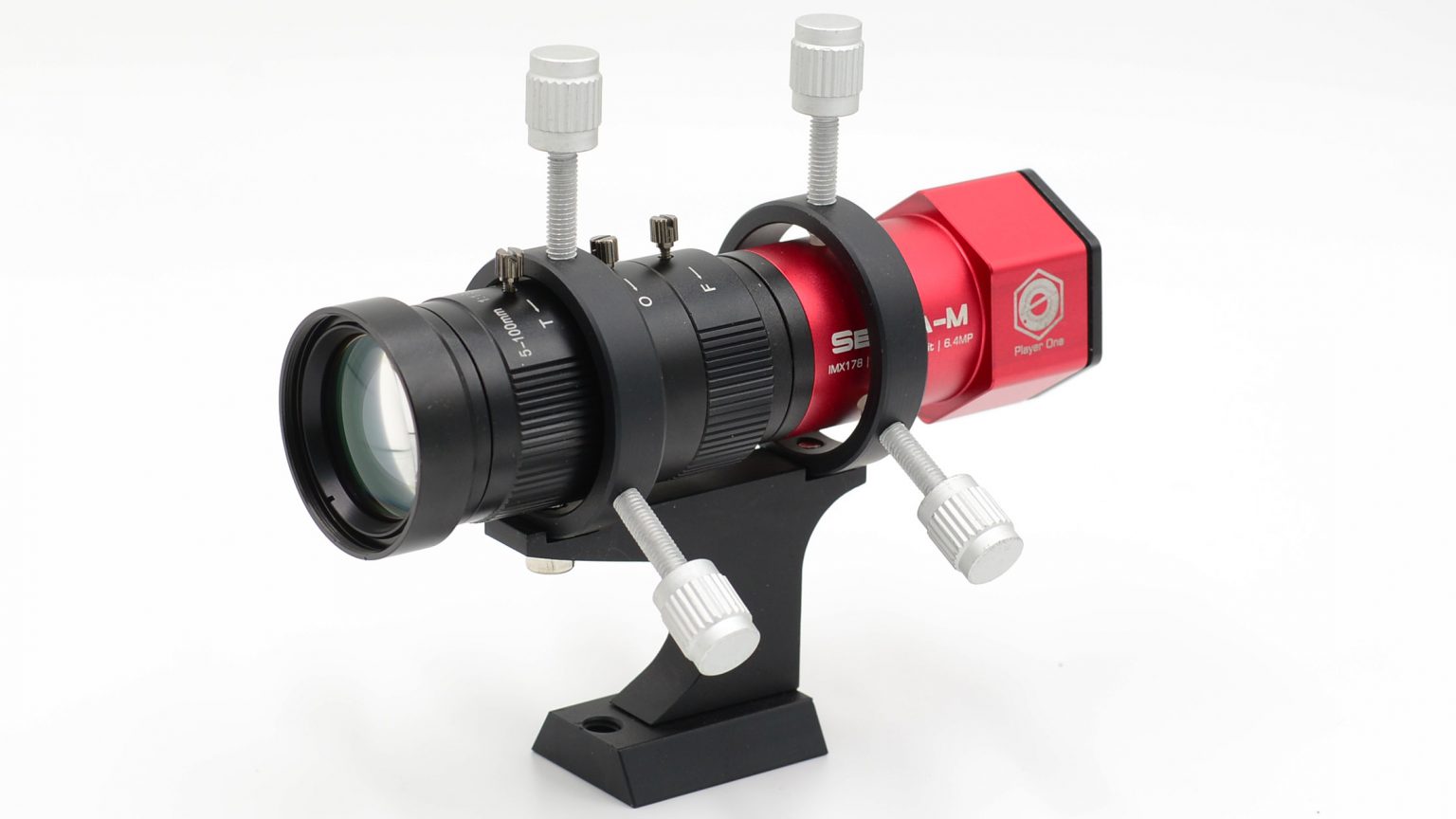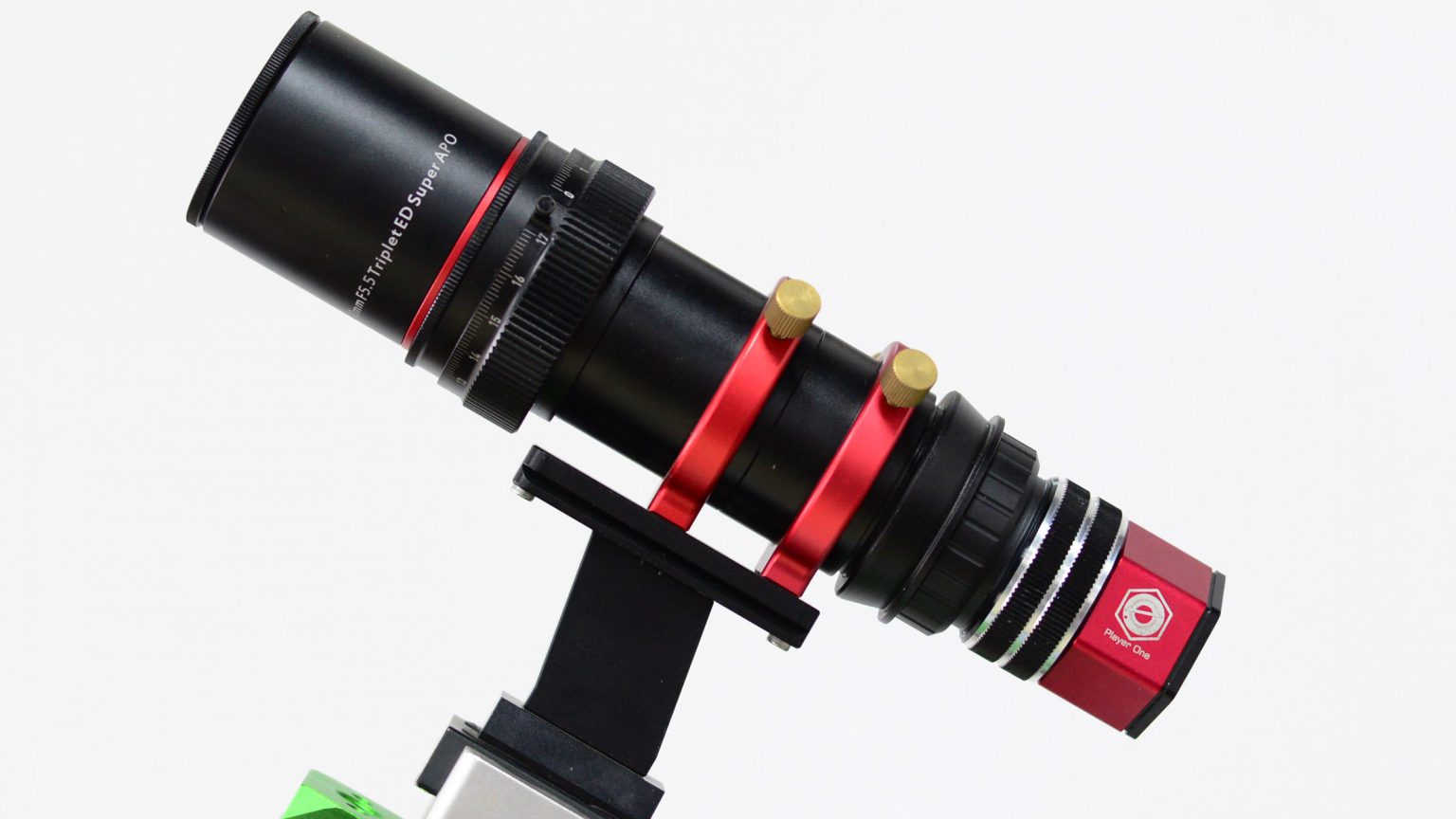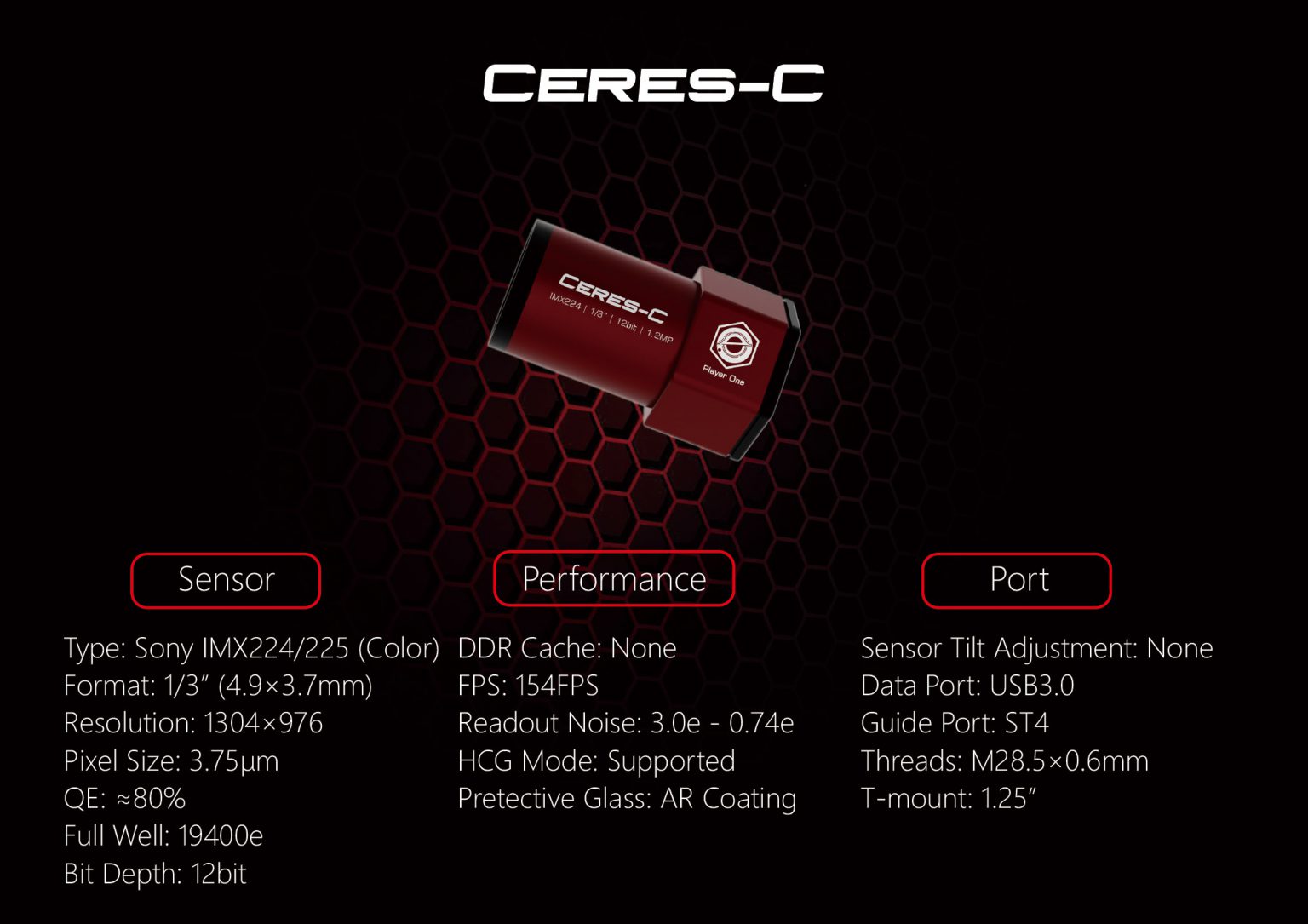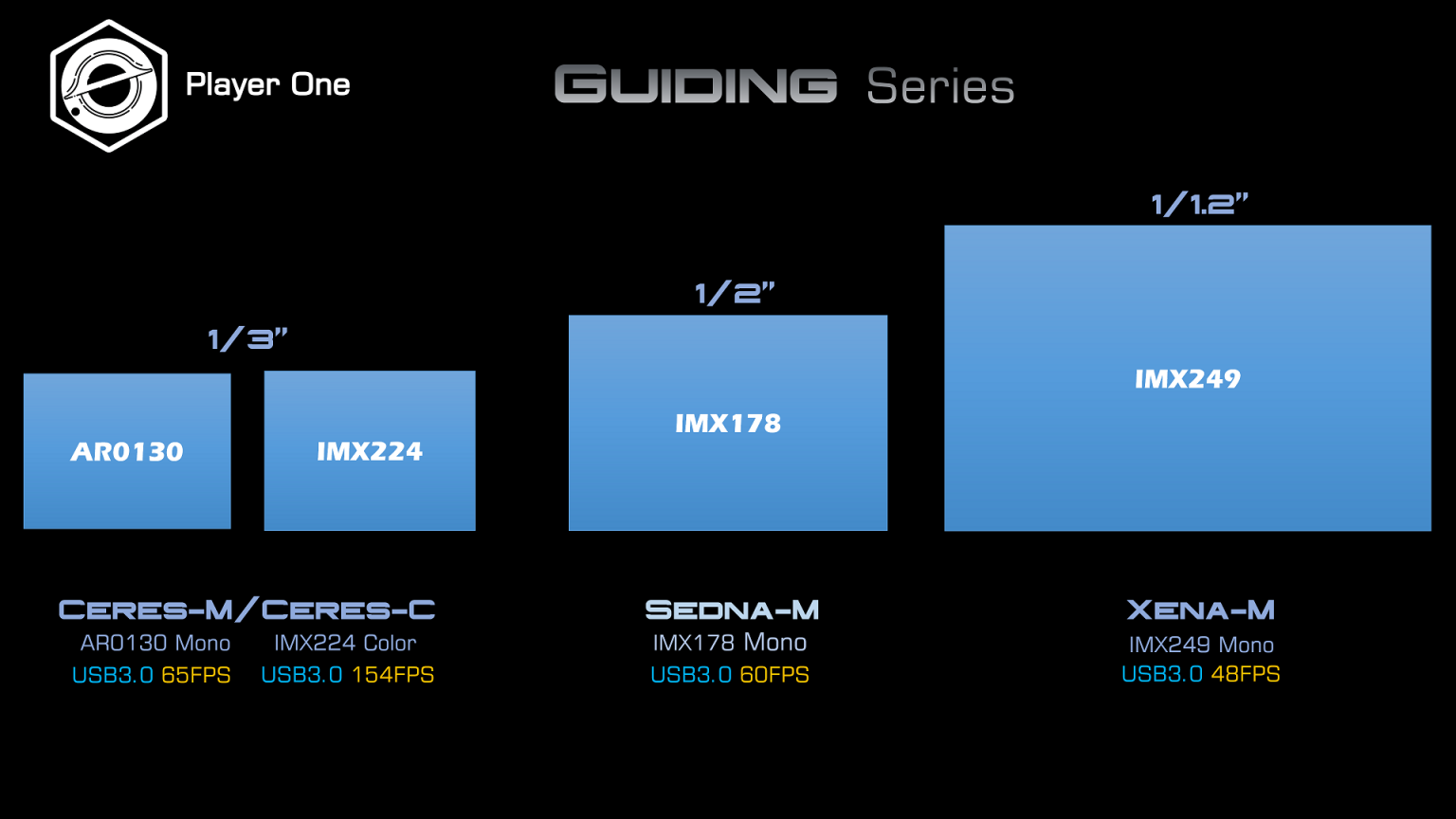Ceres-C USB3.0 Color Camera (IMX224) [PL-CERES-C]
2 in stock On sale IN STOCK, usually ships within 48h or less directly from our Canadian warehouse
Ceres-C is a guiding camera developed by Player One Astronomy, which adopts the Sony IMX224/225 1/3” format sensor. The 3.75um pixel size accommodates a well depth of 19.4ke with a total of 1.2MP (the resolution is 1304*976), and the diagonal is 6mm.
Highlights
Dwarf planet series integrated USB3.0 data port(500Mb/s), which can provide over 10 times speed than USB2.0 device(60Mb/s). Whatever you wants to do guiding or imaging, this camera series can handle it very well.Dwarf planet camera diameter is 1.25″, it can slide in 1.25″ holder of guiding scope, makes the whole setup shorter.With a 5-100MM CS lens attached on the camera, it also can be used as a guider or finder.
The naming of Player One guiding cameras is interesting. Guiding camera is smaller than planetary camera, that’s why we choose dwarf planets to name it.
The size of each dwarf planet to a certain extent represents the size of camera sensors. We will name Ceres with a 1/3″ sensor camera, and for Xena, we will name it with a 1/1.2 inch sensor camera. All names will be engraved on the housing of the cameras.
Drivers and softwares download: https://player-one-astronomy.com/service/software/
Manuals download: https://player-one-astronomy.com/service/manuals/
Cutting-edge Design
The guiding cameras developed by Player One Astronomy uses technological regular hexagon to construct the main body line.
DPS technology
The guiding cameras from Player One Astronomy have DPS (Dead Pixel Suppression) technology, dead pixels (including both hot pixels and cold pixels) of the image are swept away. DPS function is turned on during your whole imaging session, no need to worry about it !
Overvoltage and overcurrent protection mechanism
Player One cameras produced by the number one player ensures the safety of your camera and other equipment through overvoltage and overcurrent protection mechanisms.
Data Port
When the camera is connected to the USB3.0 interface and full-resolution preview is used, it can reach 154 FPS in RAW8 mode (10bit ADC). When recording images, since the actual writing speed will be affected by the writing speed of the hard disk itself, when the hard disk writing speed is slow, the recording may not reach the theoretical speed. It is recommended that you use a high-quality solid state drive to record data to give full play to the performance of the camera.
Use the ST4 guide cable to connect the camera and the AUTO GUIDE port of the equatorial mount to do guiding.
Readout Noise
Regarding readout noise, we solemnly promise that all values are obtained from actual tests. And for users, you could use Sharpcap 4 for testing. SC4 has a function called Sensor Analysis, provide a very simple way to test readout noise.
We wrote a tutorial on our website: https://player-one-astronomy.com/service/manuals/
After many rigorous readout noise tests, the Ceres-C camera can reach a low readout noise of 0.75e at a gain of 350.
If you are interested in readout noise testing, you may try it yourself, which is very simple.
About Ceres-C USB3.0 Color Camera (IMX224) [PL-CERES-C]
Player One: Ceres-C USB3.0 Color Camera (IMX224)Player One Astronomy guiding camera series, AKA Dwarf Planet Series, is design for guiding and imaging. This series including 3 sub-series, Ceres, Sedna and Xena
Ceres-C is a guiding camera developed by Player One Astronomy, which adopts the Sony IMX224/225 1/3” format sensor. The 3.75um pixel size accommodates a well depth of 19.4ke with a total of 1.2MP (the resolution is 1304*976), and the diagonal is 6mm.
Highlights
Dwarf planet series integrated USB3.0 data port(500Mb/s), which can provide over 10 times speed than USB2.0 device(60Mb/s). Whatever you wants to do guiding or imaging, this camera series can handle it very well.Dwarf planet camera diameter is 1.25″, it can slide in 1.25″ holder of guiding scope, makes the whole setup shorter.With a 5-100MM CS lens attached on the camera, it also can be used as a guider or finder.
The naming of Player One guiding cameras is interesting. Guiding camera is smaller than planetary camera, that’s why we choose dwarf planets to name it.
The size of each dwarf planet to a certain extent represents the size of camera sensors. We will name Ceres with a 1/3″ sensor camera, and for Xena, we will name it with a 1/1.2 inch sensor camera. All names will be engraved on the housing of the cameras.
Drivers and softwares download: https://player-one-astronomy.com/service/software/
Manuals download: https://player-one-astronomy.com/service/manuals/
Cutting-edge Design
The guiding cameras developed by Player One Astronomy uses technological regular hexagon to construct the main body line.
DPS technology
The guiding cameras from Player One Astronomy have DPS (Dead Pixel Suppression) technology, dead pixels (including both hot pixels and cold pixels) of the image are swept away. DPS function is turned on during your whole imaging session, no need to worry about it !
Overvoltage and overcurrent protection mechanism
Player One cameras produced by the number one player ensures the safety of your camera and other equipment through overvoltage and overcurrent protection mechanisms.
Data Port
When the camera is connected to the USB3.0 interface and full-resolution preview is used, it can reach 154 FPS in RAW8 mode (10bit ADC). When recording images, since the actual writing speed will be affected by the writing speed of the hard disk itself, when the hard disk writing speed is slow, the recording may not reach the theoretical speed. It is recommended that you use a high-quality solid state drive to record data to give full play to the performance of the camera.
Use the ST4 guide cable to connect the camera and the AUTO GUIDE port of the equatorial mount to do guiding.
Readout Noise
Regarding readout noise, we solemnly promise that all values are obtained from actual tests. And for users, you could use Sharpcap 4 for testing. SC4 has a function called Sensor Analysis, provide a very simple way to test readout noise.
We wrote a tutorial on our website: https://player-one-astronomy.com/service/manuals/
After many rigorous readout noise tests, the Ceres-C camera can reach a low readout noise of 0.75e at a gain of 350.
If you are interested in readout noise testing, you may try it yourself, which is very simple.
| Sensor |
Sony IMX224/225 CMOS (Color) |
|---|---|
| Diagonal |
6mm |
| Total Pixels |
1.2 Mega Pixels |
| Max Resolution |
1304×976 |
| Pixel Size |
3.75μm |
| Chip Size |
4.9×3.7mm |
| Frame Rate |
154FPS(10bit) |
| Shutter |
Rolling shutter |
| Exposure Range |
32μs-2000s |
| Readout Noise |
3.0e – 0.74e |
| QE Peak |
TBD |
| Full Well |
19.4k e |
| ADC |
12 bit |
| Data Port |
USB3.0/USB2.0 |
| Adapter |
1.25″ / M28.5X0.6 |
| Back Focal Length |
7.5mm |
| Protective Window |
AR coating |
| Diameter |
40mm |
| Weight |
65g |
| Resolution and FPS |
Under USB3.0 mode |
Shipping Options
Shipping options and prices may vary depending on the total value of your order. Your final shipping price will be determined at checkout.
Options shown are based on your estimated location.
-
$24.00 CAD - [zus] USPS Ground Shipping (7-14 days)
Shipping Size
-
Size0 in × 0 in × 0 in
-
Weight0 lb

